Xiyao Wang
SoTA with Less: MCTS-Guided Sample Selection for Data-Efficient Visual Reasoning Self-Improvement
Apr 10, 2025Abstract:In this paper, we present an effective method to enhance visual reasoning with significantly fewer training samples, relying purely on self-improvement with no knowledge distillation. Our key insight is that the difficulty of training data during reinforcement fine-tuning (RFT) is critical. Appropriately challenging samples can substantially boost reasoning capabilities even when the dataset is small. Despite being intuitive, the main challenge remains in accurately quantifying sample difficulty to enable effective data filtering. To this end, we propose a novel way of repurposing Monte Carlo Tree Search (MCTS) to achieve that. Starting from our curated 70k open-source training samples, we introduce an MCTS-based selection method that quantifies sample difficulty based on the number of iterations required by the VLMs to solve each problem. This explicit step-by-step reasoning in MCTS enforces the model to think longer and better identifies samples that are genuinely challenging. We filter and retain 11k samples to perform RFT on Qwen2.5-VL-7B-Instruct, resulting in our final model, ThinkLite-VL. Evaluation results on eight benchmarks show that ThinkLite-VL improves the average performance of Qwen2.5-VL-7B-Instruct by 7%, using only 11k training samples with no knowledge distillation. This significantly outperforms all existing 7B-level reasoning VLMs, and our fairly comparable baselines that use classic selection methods such as accuracy-based filtering. Notably, on MathVista, ThinkLite-VL-7B achieves the SoTA accuracy of 75.1, surpassing Qwen2.5-VL-72B, GPT-4o, and O1. Our code, data, and model are available at https://github.com/si0wang/ThinkLite-VL.
Towards Self-Improvement of LLMs via MCTS: Leveraging Stepwise Knowledge with Curriculum Preference Learning
Oct 09, 2024



Abstract:Monte Carlo Tree Search (MCTS) has recently emerged as a powerful technique for enhancing the reasoning capabilities of LLMs. Techniques such as SFT or DPO have enabled LLMs to distill high-quality behaviors from MCTS, improving their reasoning performance. However, existing distillation methods underutilize the rich trajectory information generated by MCTS, limiting the potential for improvements in LLM reasoning. In this paper, we propose AlphaLLM-CPL, a novel pairwise training framework that enables LLMs to self-improve through MCTS behavior distillation. AlphaLLM-CPL efficiently leverages MCTS trajectories via two key innovations: (1) AlphaLLM-CPL constructs stepwise trajectory pairs from child nodes sharing the same parent in the search tree, providing step-level information for more effective MCTS behavior distillation. (2) AlphaLLM-CPL introduces curriculum preference learning, dynamically adjusting the training sequence of trajectory pairs in each offline training epoch to prioritize critical learning steps and mitigate overfitting. Experimental results on mathematical reasoning tasks demonstrate that AlphaLLM-CPL significantly outperforms previous MCTS behavior distillation methods, substantially boosting the reasoning capabilities of LLMs.
LLaVA-Critic: Learning to Evaluate Multimodal Models
Oct 03, 2024Abstract:We introduce LLaVA-Critic, the first open-source large multimodal model (LMM) designed as a generalist evaluator to assess performance across a wide range of multimodal tasks. LLaVA-Critic is trained using a high-quality critic instruction-following dataset that incorporates diverse evaluation criteria and scenarios. Our experiments demonstrate the model's effectiveness in two key areas: (1) LMM-as-a-Judge, where LLaVA-Critic provides reliable evaluation scores, performing on par with or surpassing GPT models on multiple evaluation benchmarks; and (2) Preference Learning, where it generates reward signals for preference learning, enhancing model alignment capabilities. This work underscores the potential of open-source LMMs in self-critique and evaluation, setting the stage for future research into scalable, superhuman alignment feedback mechanisms for LMMs.
Multi-Stage Balanced Distillation: Addressing Long-Tail Challenges in Sequence-Level Knowledge Distillation
Jun 19, 2024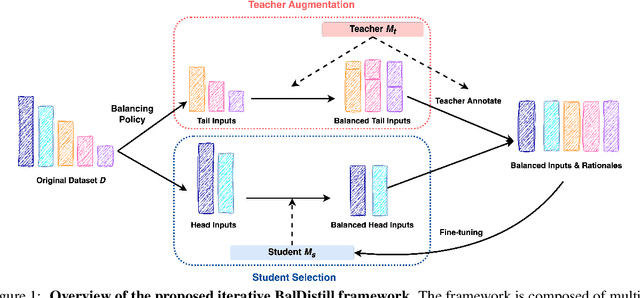
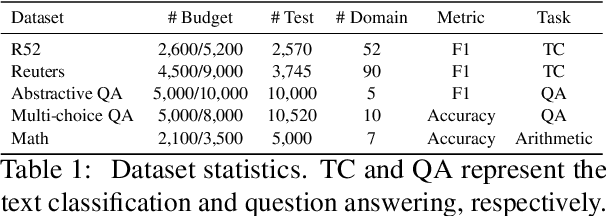
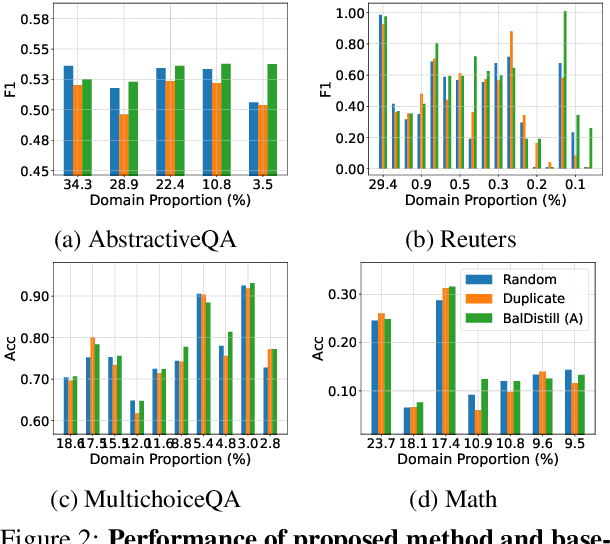

Abstract:Large language models (LLMs) have significantly advanced various natural language processing tasks, but deploying them remains computationally expensive. Knowledge distillation (KD) is a promising solution, enabling the transfer of capabilities from larger teacher LLMs to more compact student models. Particularly, sequence-level KD, which distills rationale-based reasoning processes instead of merely final outcomes, shows great potential in enhancing students' reasoning capabilities. However, current methods struggle with sequence level KD under long-tailed data distributions, adversely affecting generalization on sparsely represented domains. We introduce the Multi-Stage Balanced Distillation (BalDistill) framework, which iteratively balances training data within a fixed computational budget. By dynamically selecting representative head domain examples and synthesizing tail domain examples, BalDistill achieves state-of-the-art performance across diverse long-tailed datasets, enhancing both the efficiency and efficacy of the distilled models.
World Models with Hints of Large Language Models for Goal Achieving
Jun 11, 2024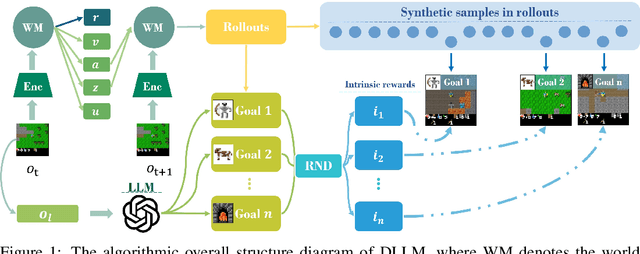

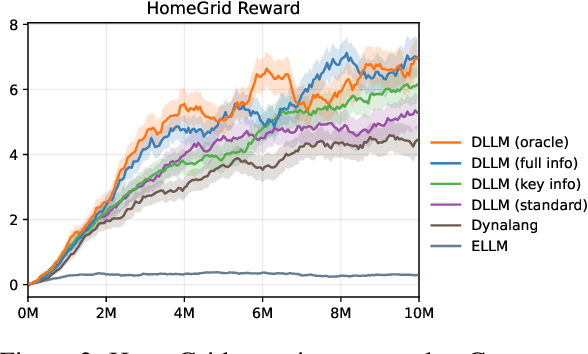
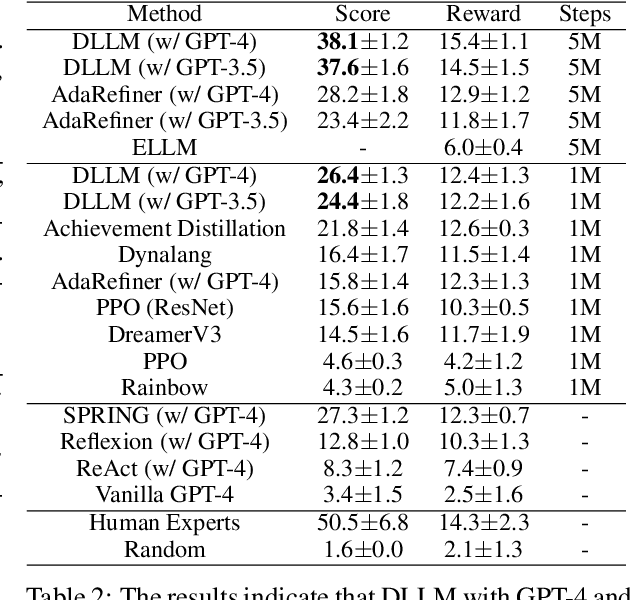
Abstract:Reinforcement learning struggles in the face of long-horizon tasks and sparse goals due to the difficulty in manual reward specification. While existing methods address this by adding intrinsic rewards, they may fail to provide meaningful guidance in long-horizon decision-making tasks with large state and action spaces, lacking purposeful exploration. Inspired by human cognition, we propose a new multi-modal model-based RL approach named Dreaming with Large Language Models (DLLM). DLLM integrates the proposed hinting subgoals from the LLMs into the model rollouts to encourage goal discovery and reaching in challenging tasks. By assigning higher intrinsic rewards to samples that align with the hints outlined by the language model during model rollouts, DLLM guides the agent toward meaningful and efficient exploration. Extensive experiments demonstrate that the DLLM outperforms recent methods in various challenging, sparse-reward environments such as HomeGrid, Crafter, and Minecraft by 27.7\%, 21.1\%, and 9.9\%, respectively.
Enhancing Visual-Language Modality Alignment in Large Vision Language Models via Self-Improvement
May 29, 2024



Abstract:Large vision-language models (LVLMs) have achieved impressive results in various visual question-answering and reasoning tasks through vision instruction tuning on specific datasets. However, there is still significant room for improvement in the alignment between visual and language modalities. Previous methods to enhance this alignment typically require external models or data, heavily depending on their capabilities and quality, which inevitably sets an upper bound on performance. In this paper, we propose SIMA, a framework that enhances visual and language modality alignment through self-improvement, eliminating the needs for external models or data. SIMA leverages prompts from existing vision instruction tuning datasets to self-generate responses and employs an in-context self-critic mechanism to select response pairs for preference tuning. The key innovation is the introduction of three vision metrics during the in-context self-critic process, which can guide the LVLM in selecting responses that enhance image comprehension. Through experiments across 14 hallucination and comprehensive benchmarks, we demonstrate that SIMA not only improves model performance across all benchmarks but also achieves superior modality alignment, outperforming previous approaches.
Calibrated Self-Rewarding Vision Language Models
May 23, 2024Abstract:Large Vision-Language Models (LVLMs) have made substantial progress by integrating pre-trained large language models (LLMs) and vision models through instruction tuning. Despite these advancements, LVLMs often exhibit the hallucination phenomenon, where generated text responses appear linguistically plausible but contradict the input image, indicating a misalignment between image and text pairs. This misalignment arises because the model tends to prioritize textual information over visual input, even when both the language model and visual representations are of high quality. Existing methods leverage additional models or human annotations to curate preference data and enhance modality alignment through preference optimization. These approaches may not effectively reflect the target LVLM's preferences, making the curated preferences easily distinguishable. Our work addresses these challenges by proposing the Calibrated Self-Rewarding (CSR) approach, which enables the model to self-improve by iteratively generating candidate responses, evaluating the reward for each response, and curating preference data for fine-tuning. In the reward modeling, we employ a step-wise strategy and incorporate visual constraints into the self-rewarding process to place greater emphasis on visual input. Empirical results demonstrate that CSR enhances performance and reduces hallucinations across ten benchmarks and tasks, achieving substantial improvements over existing methods by 7.62%. Our empirical results are further supported by rigorous theoretical analysis, under mild assumptions, verifying the effectiveness of introducing visual constraints into the self-rewarding paradigm. Additionally, CSR shows compatibility with different vision-language models and the ability to incrementally improve performance through iterative fine-tuning. Our data and code are available at https://github.com/YiyangZhou/CSR.
Premier-TACO is a Few-Shot Policy Learner: Pretraining Multitask Representation via Temporal Action-Driven Contrastive Loss
Feb 13, 2024



Abstract:We present Premier-TACO, a multitask feature representation learning approach designed to improve few-shot policy learning efficiency in sequential decision-making tasks. Premier-TACO leverages a subset of multitask offline datasets for pretraining a general feature representation, which captures critical environmental dynamics and is fine-tuned using minimal expert demonstrations. It advances the temporal action contrastive learning (TACO) objective, known for state-of-the-art results in visual control tasks, by incorporating a novel negative example sampling strategy. This strategy is crucial in significantly boosting TACO's computational efficiency, making large-scale multitask offline pretraining feasible. Our extensive empirical evaluation in a diverse set of continuous control benchmarks including Deepmind Control Suite, MetaWorld, and LIBERO demonstrate Premier-TACO's effectiveness in pretraining visual representations, significantly enhancing few-shot imitation learning of novel tasks. Our code, pretraining data, as well as pretrained model checkpoints will be released at https://github.com/PremierTACO/premier-taco. Our project webpage is at https://premiertaco.github.io.
Mementos: A Comprehensive Benchmark for Multimodal Large Language Model Reasoning over Image Sequences
Jan 25, 2024



Abstract:Multimodal Large Language Models (MLLMs) have demonstrated proficiency in handling a variety of visual-language tasks. However, current MLLM benchmarks are predominantly designed to evaluate reasoning based on static information about a single image, and the ability of modern MLLMs to extrapolate from image sequences, which is essential for understanding our ever-changing world, has been less investigated. To address this challenge, this paper introduces Mementos, a new benchmark designed to assess MLLMs' sequential image reasoning abilities. Mementos features 4,761 diverse image sequences with varying lengths. We also employ a GPT-4 assisted method to evaluate MLLM reasoning performance. Through a careful evaluation of nine recent MLLMs on Mementos, including GPT-4V and Gemini, we find that they struggle to accurately describe dynamic information about given image sequences, often leading to hallucinations/misrepresentations of objects and their corresponding behaviors. Our quantitative analysis and case studies identify three key factors impacting MLLMs' sequential image reasoning: the correlation between object and behavioral hallucinations, the influence of cooccurring behaviors, and the compounding impact of behavioral hallucinations. Our dataset is available at https://github.com/umd-huang-lab/Mementos.
Emojis Decoded: Leveraging ChatGPT for Enhanced Understanding in Social Media Communications
Jan 22, 2024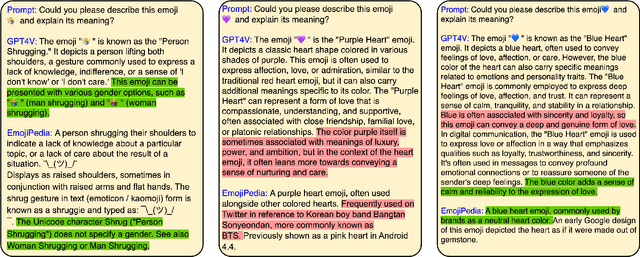

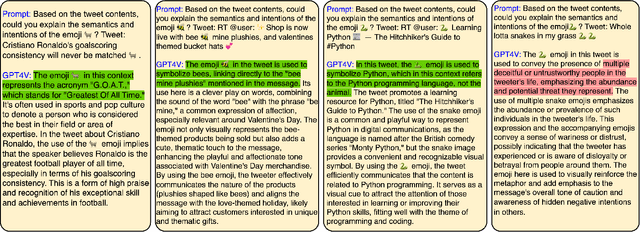

Abstract:Emojis, which encapsulate semantics beyond mere words or phrases, have become prevalent in social network communications. This has spurred increasing scholarly interest in exploring their attributes and functionalities. However, emoji-related research and application face two primary challenges. First, researchers typically rely on crowd-sourcing to annotate emojis in order to understand their sentiments, usage intentions, and semantic meanings. Second, subjective interpretations by users can often lead to misunderstandings of emojis and cause the communication barrier. Large Language Models (LLMs) have achieved significant success in various annotation tasks, with ChatGPT demonstrating expertise across multiple domains. In our study, we assess ChatGPT's effectiveness in handling previously annotated and downstream tasks. Our objective is to validate the hypothesis that ChatGPT can serve as a viable alternative to human annotators in emoji research and that its ability to explain emoji meanings can enhance clarity and transparency in online communications. Our findings indicate that ChatGPT has extensive knowledge of emojis. It is adept at elucidating the meaning of emojis across various application scenarios and demonstrates the potential to replace human annotators in a range of tasks.
 Add to Chrome
Add to Chrome Add to Firefox
Add to Firefox Add to Edge
Add to Edge